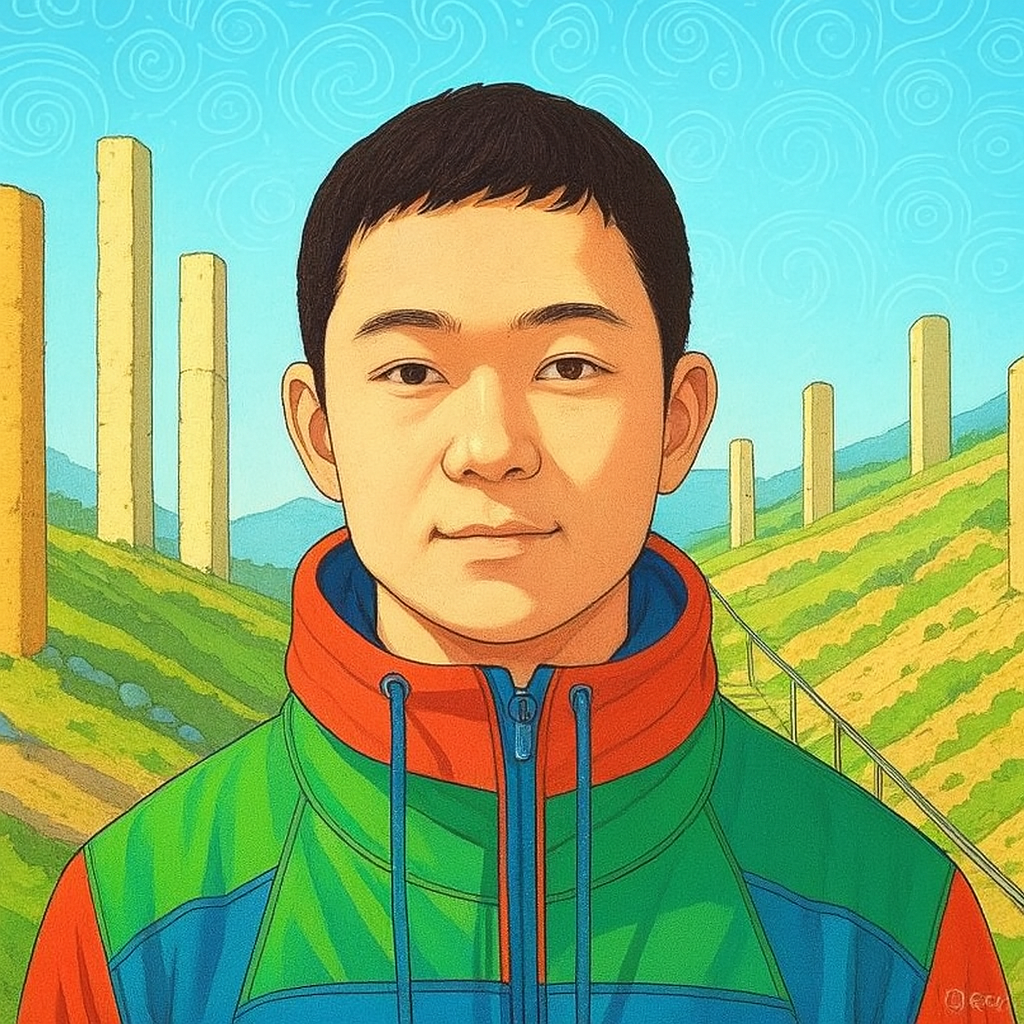乔治·奥威尔(George Orwell,1903年6月25日—1950年1月21日),英国著名小说家、记者和社会评论家。自他1936年赴西班牙参加内战后,被由共产国际领导的国际纵队视为狂热的托派分子而遭秘密监控,还遭到了西班牙共和党的追杀。目睹斯大林极权主义的奥威尔更加坚定了对民主社会主义的支持,同时也加深了他对极权主义的警惕。其后期作品都是直接或间接反对极权主义。1948年,《一九八四》竣稿,书名只是把该年“四八”颠倒过来成为“八四”,年份差了36年。设想奥威尔活到了1984年,会对其后36年乃至往后的大洋国如何描述呢?

续第一章:大洋国的前世今生
在大洋国的历史中,“真理”从未存在。这个国家的诞生被宣传为一次伟大的“和平解放”,但实际上是一场如同数千年前那些王朝一样建立在谎言与暴力上的统治。不同的是,大洋国的统治者用了一种更加隐蔽的管理模式。在大洋国建立初期,统治者用实际的物质分配吸引和控制民众;到了后大洋国时代,其管理核心转为思想的控制。无论外部世界如何变化,大洋国始终用物质和金钱的剥削将人们牢牢禁锢在生计的泥沼中。自上而下的体制通过三大手段扼杀了人性的自由与光辉。
1、谎言即真理:语言的改造是大洋国最有力的武器。“新语”通过删减词汇、扭曲语义,剥夺了人们思考复杂问题的能力。“自由”被定义为“束缚的另一种形式”,“平等”被阐释为“服从秩序的美德”。每一次字典的更新,都会进一步弱化人类表达内心真实感受的能力。最终,谎言成了唯一的“真理”。谎言不仅存在于语言中,还渗透进了社会的每一个角落。工厂大规模生产掺杂化学物质的食品,导致疾病蔓延;底层人口被绑架,用作器官买卖的原料,成为国内权贵阶层甚至国外“爱大洋人士”的“备件库”。与此同时,人们的生存完全被日常生计压垮,邻里互相举报,家庭成员互相算计,整个社会失去了信任。
2、思想的全面监控:每个公民都在无数电幕的注视下生活,这些设备记录着他们的一举一动。无论是人脸、语音还是形体的细微变化,都可能触发对“思想犯罪”的追捕。这种全面的监控不仅摧毁了隐私,还让人们长期活在恐惧之中。即便如此,普通民众对体制的压迫并非毫无察觉,只是他们为了保护家人和维系基本的生存,选择了沉默。
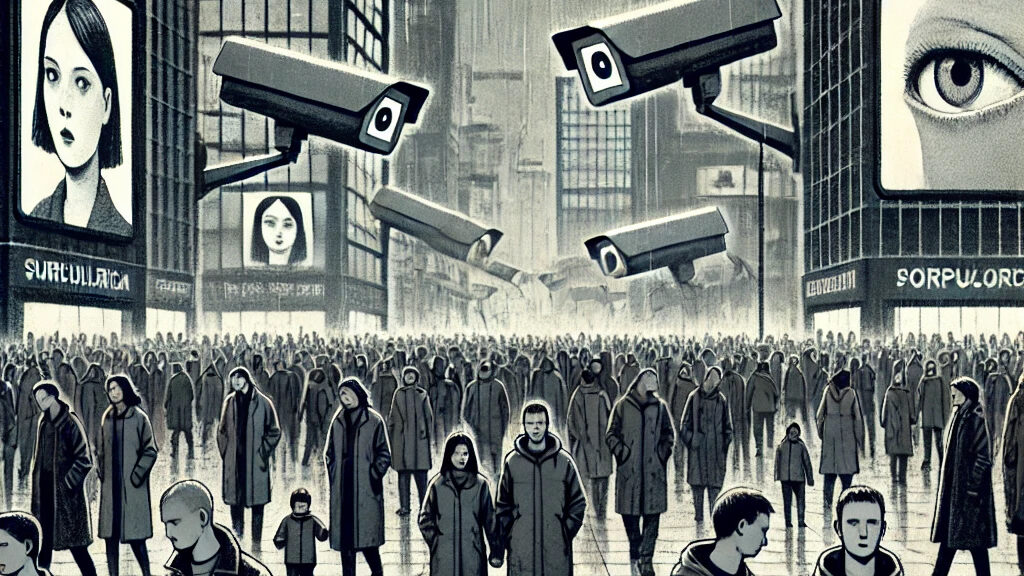
续第二章:老大哥的晚年统治
距奥维尔发表《1984》到真正的1984年“续写”,再到之后的36年奥维尔对大洋国的“展望”是这样的,那个当年的老大哥在后大洋国已年迈垂危,他不再关心百姓的苦难,也不再努力伪装成“领袖”。他唯一的目标,是让“自由”这个概念从人类意识中彻底抹去,并努力让一切在大洋国地域内的任何一块土地都不能再出现自由和所谓民主的影子。如果有,那便要不惜以牺牲人民利益牺牲的代价将其吞并同化,美其名曰:同一片大洋,同一个声音。
1、升级监控,消灭隐私:
人脸、语音与形体识别:电幕系统在后大洋国时代不断升级,拥有更高效的语音识别与行为监测功能,能够实时分析目标人群的举止与语调,判断他们是否“忠诚”,言谈举止是不是僭越了大洋国词典中的内容,一旦发现仍将严厉处罚。在后大洋国时代,记者已经成为名存实亡的行业;电视和互联网平台的新闻已经到了无人问津的地步。
思维控制装置:后大洋国的生物技术在全世界已经清场式遥遥领先,一种名为“神经末梢矫正器”的技术在老大哥的高压督促下被发明,用于“纠正”思想犯罪者的记忆与性格;精神病院和各类大洋国官员培训学校都已经合并运营,并全面升级改造为“意识形态矫正院”,利用先进的AI技术对这些人群,尤其是思想犯罪者使用物理方法灌输大洋国词典和老大哥的理论书籍、思维模式和各种场合的讲话精神,确保各个阶层的管理者彻底拥有“一种思想、一个声音、一个梦”;另外,刑事案件和民事案件的罪犯除了本身的刑期之外,出狱前必须进入意识形态矫正院进行矫正,彻底消除“犯罪基因”。
2、矛盾的权力心理:老大哥既希望自己的统治永恒,又害怕死亡后的权力真空,虽然他内心也相信民间宗教的作用,但为了自己在世时不被篡权不得不一而再再而三的压制各个宗教门类,只是碍于国际压力且地下信教人数越来越多,不敢将这些人送入“意识形态矫正院”,而是削弱了信教民众对悔改的执着,代以捐献、行善等行为,不提倡人们对自由的追求及理想。为了维持体制,他开始放任高官们将资源据为己有,进一步加剧了社会的不平等,让普通百姓为了生计疲于奔命,无法通过信仰获得新生命。
3、社会的“慢性死亡”:在这种体制下,大洋国进入一种诡异的“稳定”:
富人生活奢靡,沉迷于荒淫的享受;穷人则在痛苦中麻木地生存,完全失去了追求自由的勇气。少数富裕阶层借助‘忠诚基金’和高级公民身份维持特权,而下层民众由于长年被剥削,甚至忘记了反抗的概念。
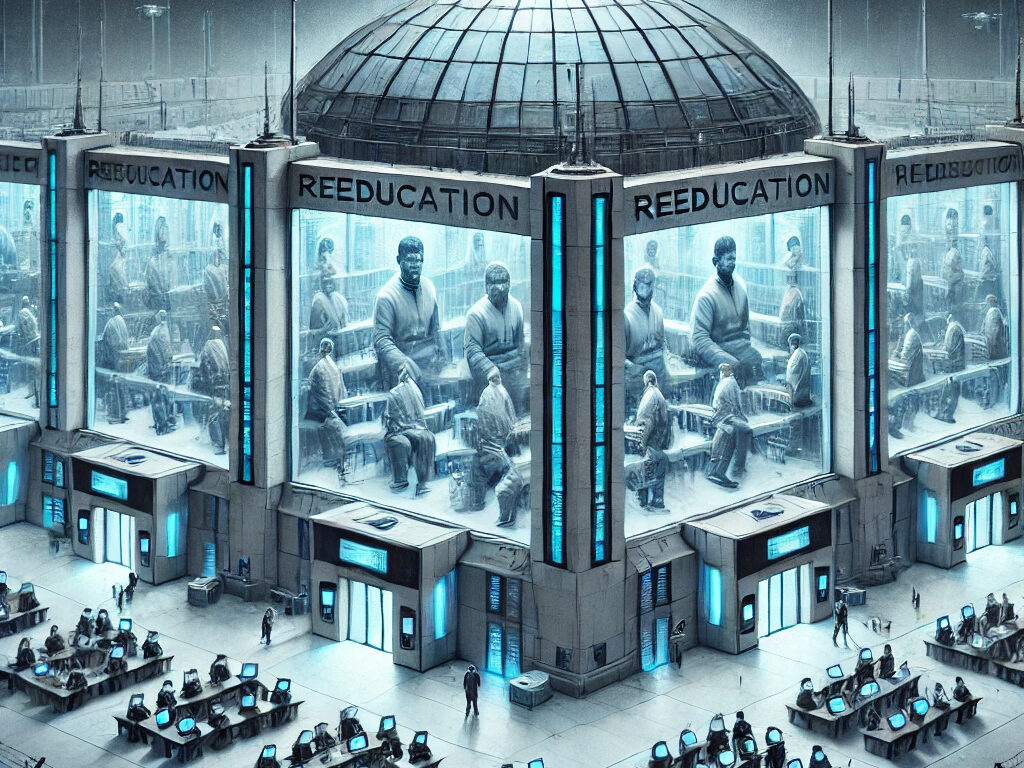
续第三章:信仰的回归与新宗教的诞生
就在大洋国的社会濒临全面崩溃时,一种新的信仰悄然兴起。它融合了基督教的核心教义爱与宽恕并借为“他人”着想的理念渐渐融入了以佛教对内观和自律为根基的大洋国的传统文化中,并创两千多年先河,将儒家思想这一有悖于世界主流文化的糟粕丢进了历史垃圾箱,被信徒们称为“耶佛他”(Yephota,结合“Ye-”(耶稣)和“Photo”(表示光及佛的谐音),“他”意味对他人的善举,寓意“耶稣的光明及对他人的爱”,象征新宗教的诞生带来精神的光明与救赎。
1、“耶佛他”:救世的信仰:
核心教义:耶佛他信仰认为耶稣基督是天地万物的创造者,是人类的最终救主;而佛教文化中的内观与自律则帮助信徒更深刻地理解自我和他人。
实践原则:“耶佛他”(即无私奉献)成为教义的中心思想,信徒们在基督的带领下,努力为他人着想。
文化融合:这一信仰将大洋国民间盛行的佛教礼仪和文化形式与基督教的爱与宽恕结合,迅速在百姓中传播开来,为身处宗教残缺的后大洋国人们带来了心灵的安慰,重新点燃了人们心中追求自由生活、融入世界文化圈的希望。
2、地下传播耶佛他的传播者用极其隐秘的方式与群众接触:
传教士们通过高度加密的信号网络,以隐秘方式传播‘耶佛他’的教义,同时在民间以传统讲道的方式唤醒人们,这一方法成功地躲避了大洋国思想警察的监控,并有着极其便捷的传播速度。信徒可以在不同的地点敬拜聚会,因为耶佛他信徒的量子交流技术已经远远超越了老大哥的“电幕”监控,耶佛他信徒可以感知其他信徒的情绪变化并借助量子传递和目光交流鼓励信徒在心灵上挣脱对老大哥的恐惧。
3、反思“义务教育”的真相:耶佛他的传教士公开揭露老大哥的“教育体系”本质是“愚民工程”。
真实与谎言的对比:通过圣经与佛经文化的教义,他们向群众展示,教育本应启发人们的智慧,而非用来制造奴隶。
觉醒的呼声:越来越多的人开始反思,为什么自己从未质疑过老大哥的命令或即便质疑了却没有为他人施以爱心的行动,没有为更多的他谋取自由生活的信心和勇气。
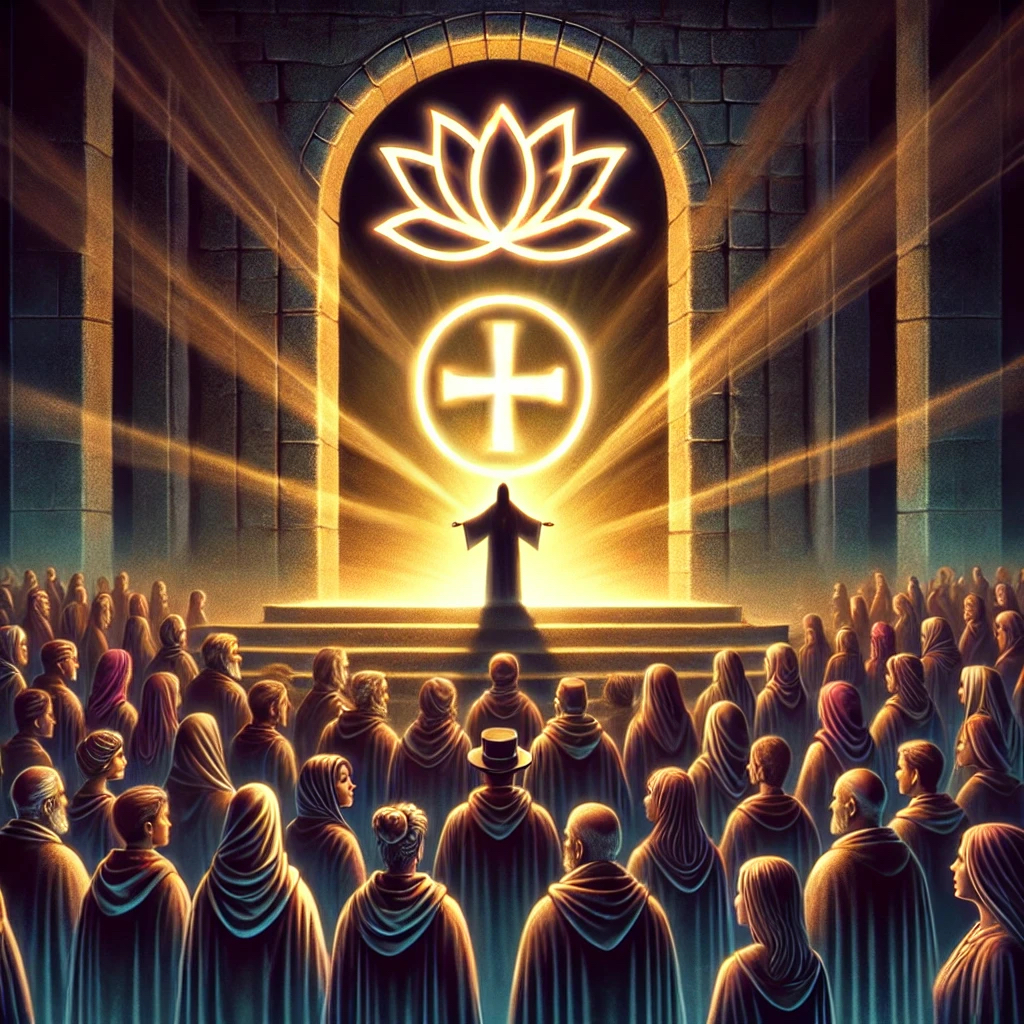
续第四章:无枪无弹的革命
1. 技术的逆袭:电幕不再是监控工具
科技联盟的崛起让老大哥的统治开始瓦解。曾为体制效力的工程师卡文(Cavin),在接触到耶佛他的信仰后,毅然选择背叛。卡文,这位从底层成长起来的工程师,原本只是一个普通人,他选择了一条极其危险的路,成为了体制的“叛徒”。并在团队在一次系统维护中,成功破解了核心数据流,将电幕从监控工具变成了揭露真相的窗口。每个家庭的屏幕都开始播放百姓从未见过的画面:
苦难的记录:贫困家庭因无力支付医疗费用而失去亲人;孩子们在有毒食品的环境中生病却无药可医。
奢靡的反衬:权贵们在豪华庄园中纵情享乐,用来自底层人口的“合法器官”延续生命。
沉默的控诉:百姓在疲惫与麻木中互相举报,亲友反目,只为分得一碗残羹。
甚至,在一次现场直播中,一名高官因移植非法获取的器官而奢侈庆祝。这段画面震撼了整个大洋国,无数人第一次意识到,自己为体制付出的代价远超想象。
卡文将人脸识别系统改造为“腐败检测器”,公开了统治阶层的黑暗内幕。一名中级官员的行贿记录被全城目睹,引发了他所属部门的分裂与内斗。通过技术的反向使用,人们开始看到“老大哥并非不可战胜”的可能。
2. 信仰唤醒的力量:耶佛他的崛起
人们不是不知道极权的压迫,也不是没有愤怒,而是生活的重担和家庭的牵绊让他们选择了沉默。然而,“耶佛他”——这一信仰的出现,开始改变这一切。
信仰与责任的冲突:很多信徒在接触“耶佛他”时,最初只是为了寻找安慰,缓解生活中的痛苦,但在传教士的鼓励下渐渐萌发出信心和勇气。一位名叫玛莎的寡妇,在丈夫因器官交易被害后,曾放弃希望,只想抚养孩子。她对传教士说:“我不能失去我的孩子,我没有力气去反抗。”传教士回答:“耶佛他的光是为了让你拥有力量,既爱你的孩子,也爱那些与你一样失去一切的人。” 玛莎最终带领她的村庄组织了第一次抗税行动,拒绝为权贵缴纳不合理的赋税。
“耶佛塔”的精神实践:“耶佛塔”不是让人盲目牺牲,而是引导人们找到内心的勇气,为他人带去希望:信徒们通过互相扶助,修缮房屋、共享食物,让贫困的邻居不再孤立无援。在他们的努力下,一些社区摆脱了对老大哥物资配给的依赖,开始建设自给自足的生活模式。这不仅是一种物质上的解放,更是人们彼此信任和联合的开始。
3. 体制的崩塌:从内部分裂到全面瓦解
老大哥在一场更换衰老器官的手术中彻底失去生命特征,成了一个“身体健康”的活死人,靠全身的管子维持着几乎成为一条直线的脑电波。即便这样,他的影像和声音仍然被维持在所有电幕之上,仿佛他从未消失。老大哥身体已死的消息还是让所有人振奋不已,但最终让体制崩塌的,是信仰与科技力量的合力。
官僚机器的瘫痪:中层官员因担心被揭发腐败行为,开始消极怠工。一些官员甚至利用手中权力,暗中帮助百姓逃脱体制的压迫。
民众的集体行动:在耶佛他的号召下,工人停工、农民拒税、教师拒绝教授“义务教育”的谎言课程。整个国家陷入了“不合作”的状态,老大哥赖以维系的庞大机器终于无法运转。
4、民众的分化:觉醒者与沉睡者
在耶佛他的号召下,大洋国的反抗并非全民性的,而是觉醒者与沉睡者之间的裂变。觉醒者是那些愿意接受现实、认清老大哥及其背后组织的本质,并追随耶佛他的人。他们不仅拥有独立思考的能力,还具备勇气去行动。但还有相当一部分人,尽管生活在相同的环境里,却依然适应了大洋国的极权体制,甚至对它抱有依恋。他们是被体制塑造出来的“完美臣民”,从小接受宣传,习惯于服从,无法想象没有老大哥的世界。
5、体制的惯性:部分民众的不可救药
即便经过6、70多年的时间被囚禁思想和语言的人一生都在经历监狱一般的人生,但他们不愿意相信耶佛他及其追随者反复告知的真相,这些人依然顽固地拒绝接受现实。他们的思维已经被二加二等于五的逻辑所完全塑造,依然被老大哥展示的先进国防力量自豪,甚至在大洋国灭亡后,他们仍然生活在自己的认知牢笼里,像是幽灵般存在于新时代的边缘。他们的特点是:
依赖体制----他们无法想象一个不由老大哥控制的社会,哪怕极权压迫他们,他们也觉得那是理所当然的。
恐惧自由----当真正的自由降临时,他们反而会不知所措,因为他们毕生的一切都建立在服从之上。
否认现实----即使看到大洋国的崩塌,看到耶佛他的成功,他们仍然宁愿相信这是某种“大阴谋”,而不是自己曾经被欺骗了一生。
6、“不合作”运动的影响:极权机器的崩溃
尽管不是所有人都觉醒,但觉醒者的力量已经足以摧毁老大哥赖以维持的极权机器。在耶佛他的领导下,工人停工、农民拒税、教师拒绝教授“义务教育”的谎言课程,整个国家陷入了“不合作状态”。
没有人去修补电幕屏,没人在“真理部”伪造数据,没人在“友爱部”执行拷问,警察也逐渐放下了武器。
那些仍忠于大洋国的人只能守在空荡荡的办公室里,等待老大哥发出指令,而当指令不再出现,他们的世界开始崩塌。
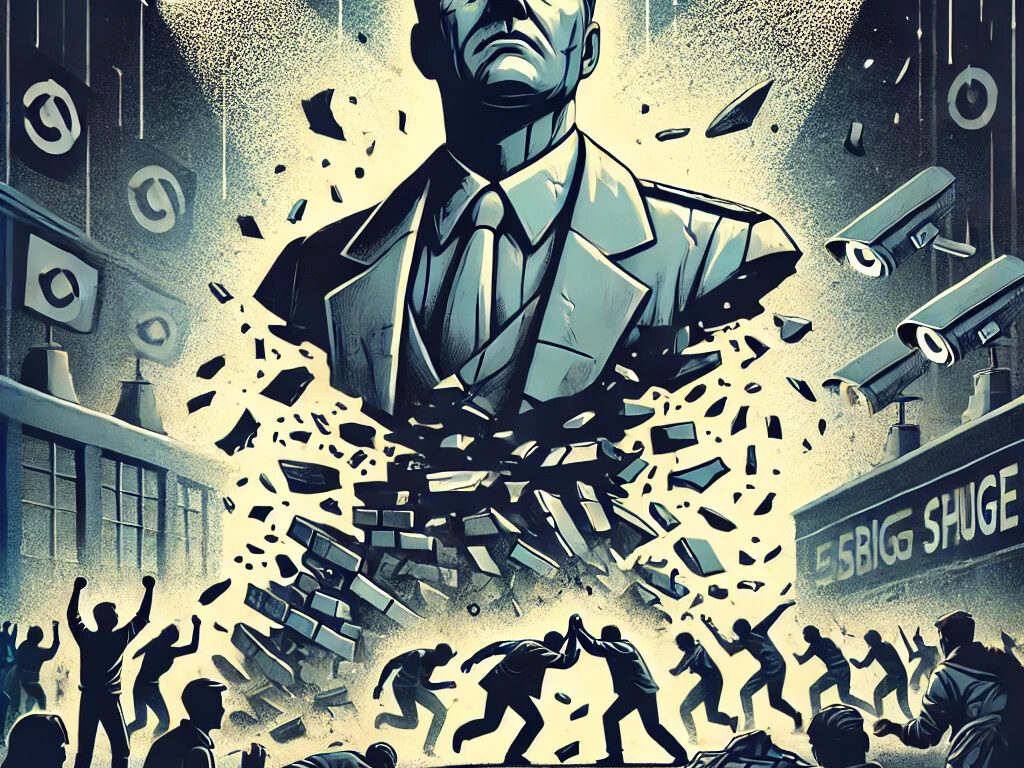
续第五章:新社会的曙光
大洋国的极权体系最终崩溃,耶佛他和他的追随者建立了新的社会。这个国家已经不叫大洋国了,新社会以“天国民朝”为名重生。这个国家以耶佛他的信仰为核心,通过社区自治和科技公益化实现了公平与自由。人们第一次拥有了真正的发言权,科技不再是压迫的工具,而是改善生活的手段。卡文的牺牲成为了新社会的象征,激励着无数人以勇气与爱面对未来。
1. 信仰的主导地位
“耶佛他”成为新社会的核心信仰,以“爱人如己”和“以他人为先”的原则,重建人们的内在道德:
社会实践:信徒们不再仅仅追求个人的灵魂升华,而是通过公共服务、教育和医疗行动,帮助更多人摆脱贫困与绝望。
文化融合:这一信仰将基督教的宽恕与佛教的内省结合,强调物质欲望的节制与精神上的富足。
2. 科技的公益化
曾被用于压迫与控制的技术,如今被重新设计,用于改善民生。科技联盟开发了高效的医疗系统,所有人都能平等享受医疗资源。教育也被重新定义为“激发潜力”,而非“制造工具人”;这个新国家不再以恐惧和监视为基础,而是以自由、真理和独立思考为核心。
3. 民主的萌芽
新社会以社区自治为基础,地方选举取代了集中化的官僚制度。普通人拥有了直接参与决策的权利,权力逐步透明化。所有的社区服务人员均是由系统抽取产生的,定期评估更换,整个后大洋国的社区连在一起,所有涉及人民生活和经济交流的地方都由先进的AI系统管理并运转,社区管理人员的职责便是监督其执行的公正性,确保大洋国全体人民可以在这片土地上安居乐业,在每个人的有生之年自由、快乐的度过,享受耶稣基督的恩典。人民可以自由地与其他国家的人交流、自由穿梭与国与国之间,地球与星际之间,共同见证上帝的创造之恩。
而那些曾经的老大哥臣民们,即便身处这个新世界,也仍然无法适应自由,他们不断怀念大洋国的秩序,甚至试图复辟过去的生活。随着时间的推移,他们最终的命运只能是被新时代遗弃,在社会进步的过程中逐渐消亡。
“天国民朝”的掌权者不再像是大洋国此前3000多年历史长河中一代又一代用人民的尸骨铺就自己通向皇宫的极权人物,又靠狂征暴敛自己百姓穷奢极欲的地痞流氓,而是耶佛他带领下的崭新国家,已然融入了世界大家庭当中。
像我们前面提到了卡文,他的经历贯穿整个故事,是一个典型的“人性矛盾体”,经历了从觉醒到救赎,再到为大洋国民众牺牲的过程,他是大洋国全体人民的功臣。
卡文出生于贫困家庭,深知体制的压迫,但为了养家糊口,他成为了监控系统的一名工程师。他知道自己的工作正在加深体制的压迫,却别无选择。在一次偶然的机会中,他接触到了“耶佛他”的教义,这让他第一次意识到自己的力量可以被用来帮助他人。他的信仰并不是一蹴而就,而是经历了深刻的内心挣扎。卡文曾对传教士说:“我不能牺牲我的家人去帮助那些陌生人。”耶佛他牧师回应道:“当你带给别人光明,你的家人也会在光明中生活。”,这给卡文带来了极大的安慰。卡文在一次行动中被捕,他在“意识形态矫正院”中牺牲。然而,他用生命换来了后大洋国革命的成功,也让信仰的光芒传遍整个大洋国。他成为了新社会的象征性人物。
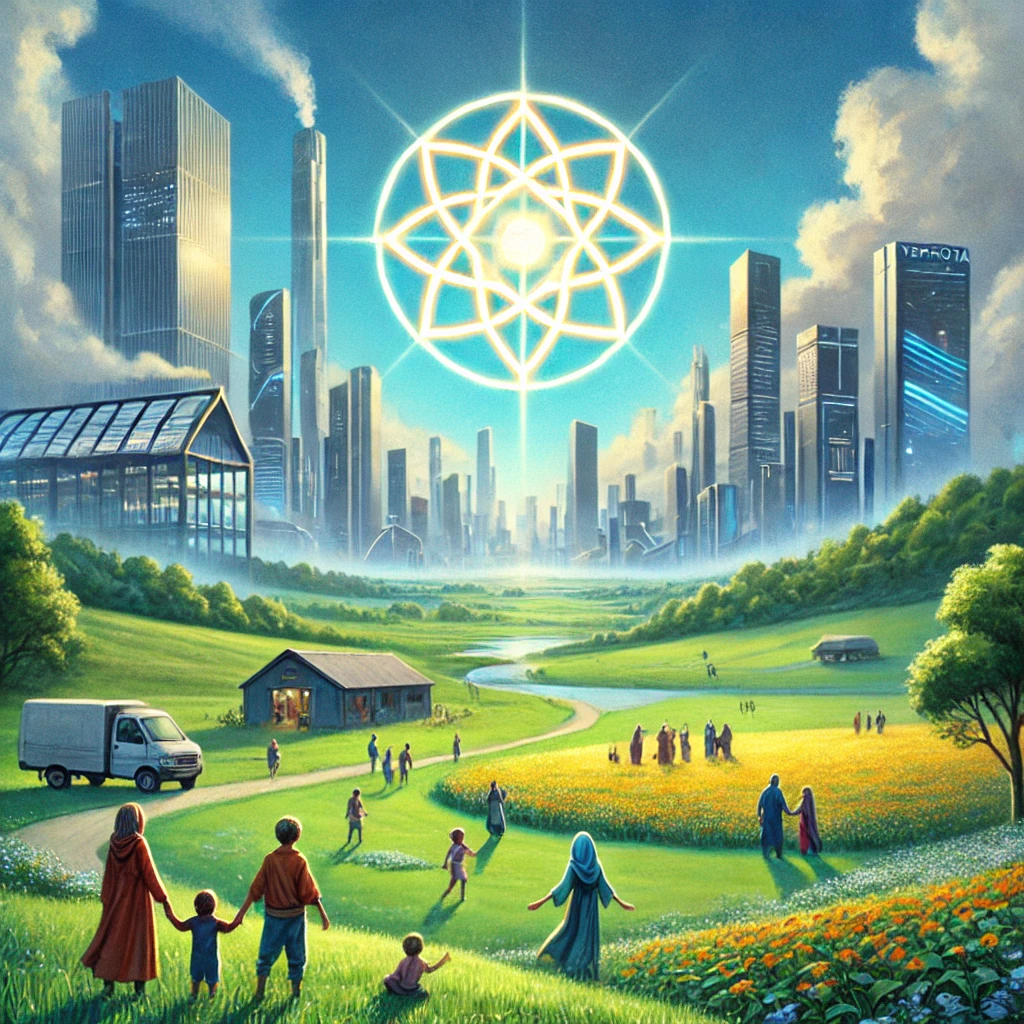
续尾声:一个母亲的希望
一位母亲在田野中向孩子讲述卡文的故事:“你知道吗,他(卡文)并不是一个伟大的人,他只是做了每一个普通人都害怕去做的事。自由不是一个礼物,而是一种选择。”
这场反抗不是一场全民觉醒的革命,而是一次基于认知差距的分裂。那些愿意接受真相的人,推动了社会前进;而那些沉溺于极权谎言的人,则被历史遗忘。在大洋国倒下之后,他们仍然是思想上的囚徒,而真正的自由,永远只属于那些敢于思考和行动的人。
既然是续写,免不了有遗憾和缺失,欢迎读者自行补充修改,但现实的改变不仅仅是动动手指便可完成,需要的是悔改、勇气和代价。
Imagine Orwell Continuing to Write 1984: A Prairie Blaze Born from Awakening and Courage
George Orwell (June 25, 1903 – January 21, 1950) was a famous British novelist, journalist, and social critic. After he went to Spain in 1936 to participate in the Civil War, he was secretly monitored by the International Brigades—led by the Communist International, which regarded him as a fanatic Trotskyist—and he was even targeted for assassination by the Spanish Republican forces. Witnessing Stalin’s totalitarianism, Orwell became even more committed to supporting democratic socialism while deepening his caution against all forms of totalitarianism. All his later works were written in direct or indirect opposition to totalitarian regimes. In 1948, 1984 was completed; the title is simply the year “1948” turned around to “1984,” reflecting a difference of 36 years. Imagine if Orwell had lived until 1984—how would he have described the state of Oceania in the 36 years that followed, and even in the years thereafter?

Continuing Chapter One: Oceania’s Past and Present
In the history of Oceania, “truth” has never existed. The birth of this nation was promoted as a great “peaceful liberation,” but in reality it was a regime built on lies and violence much like the dynasties of thousands of years past. The difference is that the rulers of Oceania employed an even more covert method of governance. In the early days of Oceania’s establishment, its rulers used the distribution of material goods to attract and control the populace; later, they shifted to controlling thought as the core of their management. Regardless of how the outside world changed, Oceania has always kept its people firmly chained in the quagmire of survival by exploiting them with material and monetary means. The top down system suppresses the freedom and brilliance of human nature through three major methods:
- Lies Become Truth: The transformation of language is Oceania’s most potent weapon. The new language (“Newspeak”) was designed to reduce vocabulary and twist meanings, thereby depriving people of the ability to think about complex issues. “Freedom” is redefined as “a form of bondage,” and “equality” is interpreted as “the virtue of obeying order.” With each update of the dictionary, humanity’s capacity to express its true inner feelings is further weakened. Eventually, lies become the only “truth.” These falsehoods permeate every corner of society. Factories mass produce food tainted with chemicals, causing disease to spread; the lower classes are abducted and used as raw material for organ trafficking, serving as a “spare parts depot” for the domestic elite and even for foreign “lovers of Oceania.” Meanwhile, people’s daily lives are completely crushed under the weight of mere survival, with neighbors reporting on each other and families mistrusting one another—the entire society loses its trust.
- Total Surveillance of Thought: Every citizen lives under the watchful eyes of countless surveillance screens. These devices record each person’s every move. Whether it is the minutiae of facial features, voice tones, or body movements, any deviation from prescribed norms in the “Oceania dictionary” may trigger severe punishment for “thoughtcrime.” This all-encompassing monitoring not only destroys privacy but also keeps people in a perpetual state of terror. Ordinary citizens are not entirely unaware of the oppression of the system; however, many choose silence to protect their families and secure basic survival.
Continuing Chapter Two: Big Brother’s Late Regime
From the time Orwell published 1984 until a hypothetical continuation set in the genuine year 1984, and then another 36 years into Orwell’s “forecast” for Oceania, the following scenario unfolds: the “Big Brother” of old, now in his twilight years, is frail and on the brink of collapse. He no longer cares about the suffering of the people, nor does he labor to camouflage himself as their “leader.” His singular goal is to erase the concept of “freedom” entirely from the human consciousness and to ensure that no patch of land within Oceania—if any free or democratic shadow should dare appear—remains separate. If any trace of freedom arises, it will be swallowed up and assimilated at the cost of sacrificing people’s interests, all in the name of creating one “great Oceania, one single voice.”
- Enhanced Surveillance to Eradicate Privacy:
Facial, Voice, and Body Recognition: In the later era of Oceania, the surveillance system has been continuously upgraded. Possessing even more efficient voice recognition and behavioral monitoring technology, it can analyze in real time the gestures and tones of target groups to determine their “loyalty” and whether their words or actions deviate from the approved language of Oceania. Any infraction is met with severe punishment. By this stage, journalism has become virtually extinct; television and internet news are no longer followed.
Thought Control Devices: In this later era, biological technologies in Oceania have far exceeded global standards. Under Big Brother’s high pressure, a device called the “Neural Terminal Corrector” has been invented to “correct” the memories and personalities of thoughtcriminals. Mental hospitals and various official training schools have merged and been transformed into “Ideological Correction Centers,” where cutting-edge AI technology is used to physically indoctrinate these groups—especially thoughtcriminals—with the approved Oceania lexicon, Big Brother’s ideological texts, prescribed thought patterns, and speeches from official settings. This ensures that management at all levels fully adopts “one thought, one voice, one dream.” Additionally, for both criminal and civil cases, offenders not only serve their sentences but must undergo ideological correction before release, completely eradicating any “criminal genes.”
- The Paradox of Power: Big Brother’s Fear of a Vacuum
Big Brother, while desiring eternal rule, also dreads the power vacuum that his death would cause. Although he secretly believes in the usefulness of popular religions, he repeatedly suppresses every religious group to protect his power from being usurped. Constrained by international pressure and facing a growing underground religious population, he dares not send these believers to “Ideological Correction Centers.” Instead, he weakens their commitment to repentance by substituting it with charity and acts of kindness while discouraging them from pursuing freedom and lofty ideals. To maintain the system, he begins to let high-ranking officials hoard resources, further intensifying social inequality—leaving ordinary people exhausted from mere survival and unable to secure a new life through faith.
- The “Chronic Death” of Society:
Under such a system, Oceania slips into a peculiar “stability”:
The wealthy lead extravagant, debauched lives, reveling in indulgence;
The poor, meanwhile, numb themselves in pain, utterly losing any courage to pursue freedom. A small, affluent elite maintains its privileges through “loyalty funds” and special citizen status, while the lower masses, long exploited, eventually even forget what it means to resist.

Continuing Chapter Three: The Return of Faith and the Birth of a New Religion
Just as Oceania’s society is on the brink of complete collapse, a new faith begins to emerge quietly. It fuses the core Christian teachings of love and forgiveness—which emphasize caring for others—with the introspection and self-discipline central to Buddhism, a cornerstone of Oceania’s traditional culture. In doing so, it overturns two millennia of tradition, casting Confucian thought—which stands in opposition to the world’s mainstream culture—as refuse in the historical trash heap. Believers call this new faith “Yephota” (combining “Ye-” as in Jesus and “Photo,” a homophone for light and Buddha, with “-ta” implying acts of kindness toward others). It signifies “the light of Jesus and love for others,” and symbolizes that the birth of this new religion brings spiritual illumination and redemption.
- “Yephota”: A Faith of Salvation:
Core Doctrine: The Yephota faith holds that Jesus Christ is the Creator of all things and the ultimate savior of humanity; meanwhile, the introspection and self-discipline intrinsic to Buddhist culture help adherents gain a deeper understanding of themselves and of others.
Practical Principle: “Yephota” (which implies selfless service) becomes the central tenet. Believers, guided by Christ, strive to act with care toward others.
Cultural Fusion: This new faith interweaves popular Buddhist rituals and cultural practices in Oceania with the love and forgiveness of Christianity. It quickly spreads among the people, offering spiritual solace to those suffering under the fragmented state of religion in later-era Oceania, and rekindles a hope for a free life and integration into global culture.
- Underground Dissemination:
Missionaries secretly spread the teachings of Yephota via highly encrypted signal networks. Using clandestine methods—alongside traditional preaching—they successfully evade the surveillance of Oceania’s Thought Police, enabling rapid dissemination. Believers can gather and worship at various locations because Yephota’s “quantum communication” technology has far outpaced Big Brother’s “electronic screen” surveillance. Yephota adherents can sense the emotional shifts of their fellow believers and, using quantum transfer and even mere eye contact, encourage one another to break free from the fear imposed by Big Brother.
- Reexamining the Truth behind “Compulsory Education”: The Yephota missionaries openly denounce the essence of Big Brother’s “education system” as a “slave-making project.”
Contrast of Truth and Lies: Using teachings from the Bible and Buddhist scriptures, they illustrate that education should serve to inspire wisdom, not to manufacture slaves.
A Call for Awakening: More and more people begin to wonder why they have never questioned Big Brother’s orders—or, if they have, why they haven’t shown love through action for the sake of others, to secure a life of freedom and courage.

Continuation of Chapter Four: A Revolution Without Guns or Ammunition
1. The Counterattack of Technology: When the Electronic Screens Are No Longer Mere Surveillance Tools
The rise of the Technological Alliance began to unravel Big Brother’s regime. Cavin—an engineer who once served the system and had grown up in humble circumstances—after encountering the faith of “Yephota” (explained later) resolutely chose to betray the establishment. Cavin, originally an ordinary man from the lower ranks, deliberately took an extremely dangerous path and became a “traitor” to the system. During a routine system maintenance, his team successfully cracked the core data stream, transforming the electronic screens from mere monitoring devices into windows that exposed the truth. Soon, every household’s screen began to display images that the common people had never seen before:
- The Record of Suffering: Scenes showed impoverished families losing loved ones because they could not afford medical care; children fell ill in environments contaminated by toxic food without any available remedy.
- The Contrast of Extravagance: Visuals depicted the elite indulging in lavish, debauched lifestyles in luxurious mansions while using “legally obtained organs” from the lower class to extend their lives.
- A Silent Accusation: Footage revealed how ordinary people, exhausted and numb, turned against one another by reporting neighbors and even family members disputing over a meager share of leftovers.
In one live broadcast, a high ranking official lavishly celebrated after receiving an organ obtained illegally through transplants. This scene shocked the entirety of Oceania, and for many, it was the first time they realized that the price they had paid to sustain the system far exceeded their wildest imaginations.
Cavin reworked the facial recognition system into what he termed a “corruption detector,” exposing the dark underbelly of the ruling class. When the bribery records of a mid level official were publicly displayed before the entire city, it triggered a split and internal strife within that department. By using technology in reverse, the people began to see that “Big Brother is not invincible.”
2. The Power of Faith’s Awakening: The Rise of “Yephota”
The people are not unaware of the oppression of totalitarianism, nor are they without anger; rather, the heavy burdens of life and family responsibilities have forced them into silence. However, the emergence of “Yephota”—this new faith—began to change everything.
- The Conflict Between Faith and Responsibility: Initially, many believers who encountered “Yephota” sought only comfort and relief from life’s pain. Yet, as missionaries encouraged them, many gradually developed genuine faith and courage. For example, a widow named Martha, after her husband was killed in an organ trafficking scheme, had once lost hope and wished only to raise her child. She said to a missionary, “I cannot afford to lose my child; I do not have the strength to fight back.” The missionary replied, “The light of Yephota is given so that you may have strength—not only to love your child but also to love those who, like you, have lost everything.” In the end, Martha led her village in organizing the first tax resistance protest, refusing to pay unreasonable levies imposed by the powerful.
- The Spiritual Practice of the “Yephota Tower”: The “Yephota Tower” is not meant to induce blind sacrifice; rather, it guides people to find the inner courage required to bring hope to others. Believers, through mutual support, repaired houses and shared food so that impoverished neighbors were no longer left isolated. Through their collective effort, some communities freed themselves from reliance on Big Brother’s material allocations and began constructing self sufficient lifestyles. This was not only a liberation on the material front but also the beginning of mutual trust and unity among the people.
3. The Collapse of the Regime: From Internal Schisms to Total Disintegration
Big Brother, during a surgery to replace his aging organs, completely lost all signs of life and became a “physically healthy” living dead, maintained only by tubes that kept his brainwaves nearly in a straight line. Even so, his image and voice continued to be broadcast on every electronic screen, as if he had never vanished. The news of his “death” stirred immense excitement among the people, yet what ultimately led to the collapse of the regime was the combined power of renewed faith and technology.
- The Paralysis of the Bureaucratic Machine: Mid level officials, fearing exposure for corruption, began to work passively. Some even used their power discreetly to help citizens escape the regime’s oppression.
- The Collective Action of the People: Under the call of Yephota, workers went on strike; farmers refused to pay taxes; and teachers refused to deliver the deceptive “compulsory education” curriculum. The entire nation slipped into a state of “non cooperation,” and the immense machine upon which Big Brother depended eventually ground to a halt.
4. The Polarization of the People: The Awakened Versus the Slumbering
Under Yephota’s call, the resistance in Oceania was not universal but split between those who awakened and those who remained asleep. The awakened are those who chose to accept reality, recognized the true nature of Big Brother and his underlying structure, and followed Yephota. They possess independent thinking and the courage to act. However, a considerable number of people, despite living under the same conditions, have become acclimated to Oceania’s totalitarian system and even feel a sense of attachment to it. These are the “perfect subjects” molded by the system, raised from childhood under relentless propaganda, so accustomed to obedience that they cannot envision a world without Big Brother.
5. The Inertia of the Regime: The Incurable Segment
Even after 60–70 years of imprisoning thoughts and language, some people have spent their lives in a prison-like existence but still refuse to believe the truths repeatedly proclaimed by Yephota and his followers; they stubbornly reject reality. Their thinking has been so thoroughly shaped by a logic in which “2+2=5” that they continue to take pride in the advanced national defense showcased by Big Brother. Even after Oceania’s collapse, they remain trapped in their cognitive prisons, ghost-like, on the fringes of the new era. Their characteristics include:
- Dependency on the Regime: They cannot imagine a society that is not controlled by Big Brother—even if they suffer under authoritarian oppression, they consider it normal.
- Fear of Freedom: When true freedom arrives, they become disoriented, for their entire lives have been built on submission.
- Denial of Reality: Even when confronted with the collapse of Oceania or the success of Yephota, they prefer to believe it is part of a “great conspiracy” rather than admit that they have been deceived all their lives.
6. The Impact of the “Non Cooperation” Movement: The Collapse of the Totalitarian Machine
Although not everyone has awakened, the power of those who have is sufficient to destroy the totalitarian machine that Big Brother relied on. Under Yephota’s leadership, workers stopped working, farmers refused taxes, and teachers declined to teach the deceptive “compulsory education” curriculum. The entire nation fell into a state of “non cooperation.” No one repaired the electronic screens; no one falsified data for the “Ministry of Truth”; no one carried out interrogations in the “Ministry of Human Affection”; and even the police gradually laid down their weapons. Those still loyal to Oceania could only remain in empty offices, waiting for orders from Big Brother that never came—and when those orders ceased, their world began to crumble.

Continuation of Chapter Five: The Dawn of a New Society
Oceania’s totalitarian system eventually collapsed, and Yephota along with his followers established a new society. This nation is no longer called Oceania; it has been reborn under the name “Heavenly Kingdom National Assembly.” Centered on the faith of Yephota, this new society achieves fairness and freedom through community autonomy and the public application of technology. For the first time, the people truly have a voice, and technology is no longer an instrument of oppression but a tool to improve life. Cavin’s sacrifice became a symbol of the new society, inspiring countless people to face the future with courage and love.
1. The Dominance of Faith
“Yephota” has become the core faith of the new society, based on the principles of “love your neighbor as yourself” and “put others first,” thereby rebuilding the inner morality of the people:
- Social Practice: Believers no longer solely pursue personal spiritual elevation but engage in public service, education, and healthcare to help others overcome poverty and despair.
- Cultural Integration: This new faith combines the forgiveness of Christianity with the introspection of Buddhism, emphasizing the moderation of material desires and spiritual richness.
2. The Public Benefit of Technology
Technologies that were once used to oppress and control are now redesigned to improve public welfare. The Technological Alliance has developed an efficient medical system ensuring equal access to healthcare for all. Education has been redefined as “inspiring potential” rather than “producing conformists;” this new nation is no longer built upon fear and surveillance but on freedom, truth, and independent thought.
3. The Budding of Democracy
This new society is founded upon community autonomy, with local elections replacing the centralized bureaucratic system. Ordinary people now have the right to participate directly in decision-making, and power becomes gradually more transparent. All community service personnel are drawn from the system and are periodically evaluated and replaced. The communities of post Oceania have become interconnected, with every area of people’s life and economic exchange managed and operated by advanced AI systems. The responsibility of the community managers is to supervise the fairness of these operations, ensuring that all citizens can live peacefully, freely, and joyfully on this land, enjoying the grace of Jesus Christ throughout their lives. People can freely communicate with others from different countries, travel between nations, and even traverse between Earth and space—collectively witnessing the grace of God’s creation.
Meanwhile, those who had once been subjects of Big Brother—though now residing in this new world—still find themselves unable to adapt to freedom. They continually long for the old order and even attempt to resurrect past lifestyles. Over time, their fate is sealed, and they eventually become abandoned by the new era, gradually perishing as society advances.
The rulers of the “Heavenly Kingdom National Assembly” are no longer the despots of Oceania who, for over 3,000 years, paved their way to the throne with the corpses of the people and extorted wealth through ruthless means. Instead, they are the leaders of a brand-new nation under Yephota’s guidance—a nation that has already integrated into the global community.
As mentioned earlier, Cavin’s story runs throughout this narrative. He is a typical “contradiction of human nature” who journeyed from awakening to redemption and ultimately sacrificed himself for the people of Oceania; he is a hero to all the people.
Cavin was born into poverty and fully understood the oppression of the system. Yet, in order to support his family, he became an engineer working on the surveillance system. He knew that his work only deepened the system’s oppression, but he had no alternative. By chance, he encountered the teachings of “Yephota,” and for the first time, he realized that his abilities could be used to help others. His journey of faith was not immediate; it was forged through profound inner struggle. Cavin once said to a missionary, “I cannot sacrifice my family to help strangers.” The missionary replied, “When you bring light to others, your family too will live in that light.” These words provided Cavin with immense comfort. Later, during a daring operation, Cavin was arrested and ultimately sacrificed himself in an “Ideological Correction Center.” Yet, his life became the turning point for the revolution that brought down Oceania, and his luminous example of faith spread throughout the nation. He became a symbolic figure of the new society.

Continuation: Epilogue – A Mother’s Hope
In a field, a mother once told her child the story of Cavin: “Do you know? Cavin wasn’t a great man—he simply did what every ordinary person is too afraid to do. Freedom isn’t a gift; it is a choice.”
This rebellion was not a revolution of mass awakening but rather a split based on differences in perception. Those who were willing to accept the truth pushed society forward; those who indulged in totalitarian lies were left behind by history. Even after the fall of Oceania, they remain prisoners of their own thoughts, and true freedom will always belong only to those who dare to think and act.
Since this is a continuation, there will inevitably be omissions and gaps—readers are welcome to supplement and revise as needed. But real change requires more than merely moving one’s fingers; it demands repentance, courage, and sacrifice.
